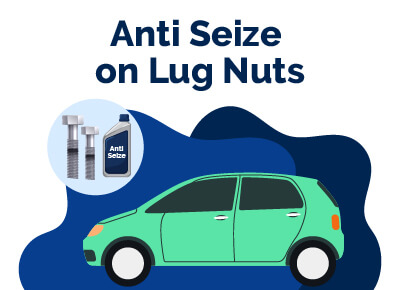All You NEED To Know About Using Anti-seize On Lug Nuts
July 22, 2023


Chris is Head of Content for FindTheBestCarPrice and is based out of Philadelphia, PA. As a seasoned automotive industry analyst and car enthusiast, he ensures the highest level of quality across all our content and curates our picks for the best deals each month.
Chris studied information systems and marketing at Drexel University and writes about a wide range of topics ranging from car buying tips to troubleshooting common mechanical issues.
When he’s not thinking about cars, he likes to stay in with his dog and make an “attempt” to finish a crossword puzzle (he’s not quite at the Saturday/Sunday level…yet). As a former cheesemonger, Chris still has a “sharp” passion for all things cheese, and his fridge is always loaded with it!
Chris also has a passion for things that go fast, and drones are no exception. He spends some of his time writing for Dronesourced.
There has been an unending argument about the effect of anti-seize on lug nuts. Some experts suggest that drivers shouldn't use anti-seize on lug nuts.
There are rumors that using anti-seize will loosen your wheel nuts and affect the torque of your studs, weakening or causing them to break off. But is this true?
Is using anti-seize on lugnuts bad, or are these just made-up engineering lessons? How can you prevent rust and lubricate the wheel nuts if using anti-seize is bad?
We advise against the ‘heavy’ use of anti-seize on lug nuts. Anti-seize will affect how your nuts are torqued, as torquing is usually better on dry threads.
However, there will be certain situations that will call for the use of anti-seize. To ensure that you don’t compromise your safety, use it sparingly.
Read on to learn more about the use of anti-seize on lug nuts!
Table of Contents
Can You Put Anti-Seize on Tire Lug Nuts?
There isn’t a yes or no answer on the idea of putting anti-seize on tire lug nuts. This is because while there are negative implications to using anti-seize on lugnuts, it also has advantages.
Applying anti-seize on your lugnuts affects your torque, making it very easy for you to over-torque the nuts. Then, there’s the worry that using anti-seize will loosen the nuts.
While some of these claims aren’t verifiable, we will advise that if you ever need to put anti-seize on your tire lugnuts, ensure that you only apply a thin coating. The use of a thin coating of lugnuts will protect your lugnuts and prevent them from rusting, corroding, or drying up due to age.
So, can you put anti-seize on tire lug nuts? Yes, and no! Funny, right? The truth is, you’ll be damned if you put anti-seize on tire lug nuts, but you will also be damned if you don’t.
Nobody wants to continue driving with rust on their lugnuts, and you cannot achieve the perfect torque on rusted threads.
It is important you know that we took a study on the numerous reports on the dangers of what anti-seize can do to your lug nuts. We figured out that the use of anti-seize on lugnuts isn't where the problem is. The dangers arise from the “improper application” of anti-seize on the nuts.
If you decide to put anti-seize on your tire lugnuts, ensure that the application is only on the fastener threads. Don’t put anti-seize under the bolt heads or directly on the nuts because it will significantly increase axial loads.
There are lots of other areas that you should not apply anti-seize, like the contact area between where the lug ends and where it joins with the rim lug recesses.
Avoid putting anti-seize on areas where the rim makes contact with the rotors, hub, or brake drum. This will prevent the transverse joint movement that causes the loosening of bolts and threaded fasteners.
The truth is that, no matter what you do, understand that using anti-seize on lug nuts has its benefits and defects. For you to be safer, we advise you to use something less thick than anti-seize for your lubrication while still ensuring that the lubrication is sparingly and evenly spread out.
Does Anti-Seize Affect Torque?
Yes. The use of anti-seize can affect your torque specifications and sometimes fool your torque wrench, making it a bit difficult to get the accurate torque value.
Anti-seize acts as a lubricant, and this plays a great role in reducing the friction load between threaded surfaces and the bolt. This decreases the torque, thereby changing the torque-tension relationship between the fastener system and the torque settings that should be achieved.
Using anti-seize drastically reduces the friction in the thread, but its effects can vary based on the anti-seize you are using. Different anti-seize uses different oil lubricants that work differently on different materials.
To ensure that much damage is not done, you will need to recalculate your torque value to compensate for the loss of friction in the system. Some mechanics will suggest reducing your torque value by 25% to 30% if you use an anti-seize.
Will Anti-Seize Cause Lugnuts To Loosen?
Yes. The use of anti-seize will cause your lugnuts to loosen if applied wrongly. What usually causes the loosening of lugnuts is the improper application of anti-seize. This means that if a lugnut is properly torqued, even if you apply anti-seize, the nuts will not loosen.
Lugnuts usually loosen because of transverse movements, which can be influenced by vibration, shock, or even dynamic loads. Transverse joint movements will only occur in lugnuts if you misuse the anti-seize. This includes applying in the wrong positions or excessive quantity.
Here are places where you should not put anti-seize:
- Damaged bolts or threads
- The back side of the rim where it makes contact with the rotors, brake drums, or hub
- Caliper Slide Pins
- Spark Plugs
- Rubber Seals
Don’t forget that you must apply strict caution if, for any reason, you wish to put anti-seize on your lug nuts.
How Can You Safely Put Anti-Seize on Lugnuts Without Affecting Torque?
Here are six ways that you can put anti-seize on your lugnuts without affecting torque:
1. Apply in Small Quantity
The first way to safely put anti-seize on your lugnuts is by sparingly applying it. Don’t apply too much anti-seize on your nuts, as this can attract lots of dirt and debris, contaminating the thread.
A small amount of anti-seize will protect your lug nuts from rust and corrosion, making it easy for you to replace your wheels without any hassle. You will only end up complicating issues for your vehicle if you habitually add excessive anti-seize.
2. Use a Hand Wrench
This might not be the type of advice that you will get from an engineering textbook. From experience and years of using anti-seize on my lugnuts, I have noticed that getting the correct torque with a hand wrench is easier, especially if you have anti-seize on your wheels.
There are multiple reports of broken studs from using an impact wrench, but you will hardly hear of a broken stud from a hand wrench, even with anti-seize. There’s a chance for an impact wrench to produce more axial force, more than a hand torque wrench.
I have seen impacts break dry studs off, but I bet nobody has ever broken a stud off using a hand torque wrench and anti-seize on the lug studs. An impact wrench on dry lug studs will probably produce more axial force than a hand torque wrench on lug studs coated with anti-seize.
However, the most important issue isn't whether you use an impact wrench or a hand wrench. The problem lies in calculating your nuts' proper torque value after applying lubrication.
3. Reduce Torque Value
Many controversies exist regarding how tight or loose your lug nuts should be after applying anti-seize.
Some mechanics will advise that you stick to the manufacturer’s specifications. At the same time, some will suggest that you reduce the torque value by a certain percentage, which will compensate for the increase in axial loads due to the anti-seize application.
To safely put anti-seize on your lug nuts, we advise you to stick to the manufacturer’s specifications, especially if you apply the anti-seize sparingly. You can reduce the torque value by 25% - 30% if it is heavily lubricated.
4. Choose the Right Anti-Seize
There are different types of anti-seize out there in the market. There are copper-based anti-seize, zinc-based, aluminum anti-seize, nickel-based anti-seize, and lots more.
You can go for a copper anti-seize based on its high-temperature tolerance. Nickel-based anti-seize is a better choice, especially if you also wish to avoid copper contamination,
5. Apply in the Right Places
Always apply anti-seize in the right places. Do not use anti-seize on moving parts, damaged threads, or exposed threads that are prone to contamination.
What Can I Use Instead of Anti-Seize?
There are a lot of lubricants that you can use instead of anti-seize. You can use grease, lubricating oil, transmission fluid, WD-40, etc.
However, you must know that certain limitations arise from using these anti-seize alternatives. For instance, grease cannot withstand high temperatures as oil burns at around 400°F, but anti-seize can withstand temperatures as high as 1300° F - 2600° F.
Conclusion
the use of anti-seize on lugnuts has its benefits and drawbacks. However, it's better that you study the views of your car's manufacturer, read up on the torque rating for your car, and apply accordingly. This will prevent you from getting in harm's way.
Best Car Deals by Category
Posted in Car Buying Tips, Car Troubleshooting |




